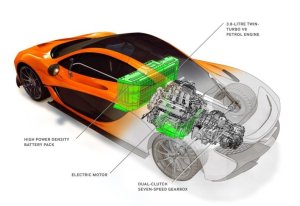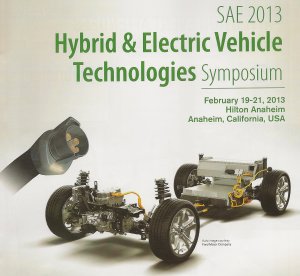Simanaitis Says
On cars, old, new and future; science & technology; vintage airplanes, computer flight simulation of them; Sherlockiana; our English language; travel; and other stuff
HYPER HYBRIDS
THE 2013 SAE Hybrid & Electric Vehicle Technologies Symposium was held this past week in Anaheim, and I profited from three days of interaction with experts in the field.
I’m in the process of assembling other mini-essays on the event, but one exciting aspect is a realization that hybrids have become mainstream in a paradoxical way—with incredibly high-performance variants. In the F70, P1 and 918, respectively, Ferrari, McLaren and Porsche have hyperexotic cars exploiting the road-going hybrid concept.
The Ferrari F70 is scheduled to make its debut at the 2013 Geneva Show in early March. Its carbon-fiber monocoque was shown at the 2012 Beijing Motor Show; recently, two teaser photos of the car were released.
The F70 features HY-KERS, Ferrari’s moniker for its hybrid layout exploiting a kinetic energy recovery system. The latter is said to be based on Ferrari’s Formula 1 KERS, though, in fact, a road-going system can be fed by the engine as well as brake regeneration. (F1 regulations prohibit engine refreshment of battery energy for the race cars.)
A mid-mounted V-12 of 6.3 liters is the expected powerplant producing upwards of 800 hp.

The F70’s smaller electric motor is linked to its 6.3-liter V-12 and runs auxiliary systems. Its primary motor resides aft of the gearbox, with power electronics atop the transaxle.
Two electric motors are part of the system. One integrated within the gearbox contributes perhaps an added 120 hp to power the car. The other motor is said to provide electrical power for auxiliary systems.
No explicit mention is made of the battery pack, but it’s likely lithium-ion with plug-in capability. Part of the hyperexotic hybrid appeal is some degree of battery-supported pure EV range, ostensibly for limited maneuvering within the BEV-only rings of European cities.
The F70’s price is expected to be north of $1.5 million.
The McLaren P1, also appearing at Geneva, is another mid-engine rear-drive hybrid, this one announced as a plug-in.
The P1’s 3.8-liter twin-turbo V-8 produces 727 hp. This is teamed with an electric motor boosting total output to 904 hp—and a total 664 lb.-ft. of torque.

The McLaren P1’s layout displays another variation of the hybrid theme. Given its modest pure-EV range of 6 miles, the item labeled “battery pack” appears particularly large.
A liquid-cooled lithium-ion battery is said to provide 6 miles of BEV-mode propulsion, again, for maneuvering in no-carbon zones. The battery charge comes from brake regeneration and the engine as well as a plug.
Advanced control features include IPAS, an “instant power assist system” actuated by a button on the steering wheel, as well as a drag-reduction system that alters the rear wing, Formula DRS style, for high-speed motoring.
The McLaren P1 is expected to be priced at more than $1 million.
The Porsche 918 is the oldest as well as most innovative of these three hyper hybrids. Initially seen at 2010 Geneva, the 918 is a plug-in hybrid, but with electrical boost to front as well as its rear wheels. It’s scheduled to enter production in September 2013.
The 918’s 4.6-liter V-8 produces 580 hp, with a pair of electric motors adding 243 hp. One producing 114 hp is integrated within the Porsche’s rear-mounted 7-speed twin-clutch gearbox and rear drive. The other motor sends its 127 hp to the front wheels.
The 918’s lithium-ion battery pack residing aft of the cockpit is liquid-cooled, with 6 kWh of energy. Recharge depends on brake regeneration, engine coasting as well as plug-in.
Unlike these other two hyper hybrids, I’ve seen this 821-hp 918 in action and know more about its operation.
There are four driving modes. E-Drive offers perhaps 25 miles of range or speeds as high as 100 mph (but evidently not simultaneously!). Hybrid, Sport and Race settings are increasingly high-performance—albeit, decreasingly green.
But, of course, green is only one aspect of these hyperexotic hybrids. They’re a long way from tree hugging. ds
© Dennis Simanaitis, SimanaitisSays.com, 2013









Dennis, thanks for another interesting report. There is probably good reason, but why would Porsche complicate the gearbox assembly instead of having all the electric components up front, improving the weight distribution as well.